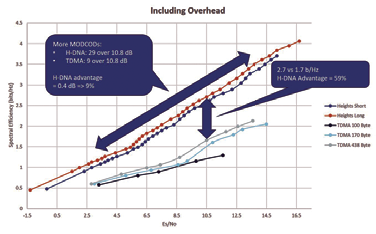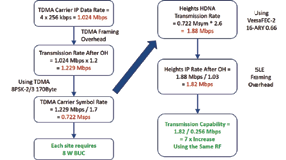The entire telecom industry is consumed with trying to answer one question: How can we cost effectively keep up with the insatiable consumer appetite for higher data rates? Applications and technologies such as Cloud applications, enhanced real-time collaboration, IoT, social media, OTT streaming video, and other applications have created today’s business environment that relies on instant access to everything, everywhere, all the time. New technologies and applications continue to arrive which demand even more connectivity. The problem is that all of the demand is outstripping the capabilities of the installed systems. Networks that were recently installed are now straining to keep up.
How can you keep up with this growing torrent without breaking the budget? How can you provide more for less? We believe that efficiency holds the answer.

The Value of Efficiency
At Comtech EF Data, efficiency is at the core of everything that we do. The vast majority of VSAT platforms today use a technology called TDMA on the return link. In fact, so many VSAT platforms use TDMA that many people may not even be aware that alternatives exist. Comtech EF Data’s Heights Dynamic Network Access (H-DNA) is such an alternative technology and has the important benefit of being significantly more efficient than TDMA systems. H-DNA combines the efficiency of SCPC — the use of high-performance coding with very low overhead – with the ability to respond to bandwidth changes on a sub-second basis.
There are two fundamental resources in satellite networks – bandwidth and power – and efficiency improves the use of both. Spectral Efficiency, measured in bits per Hz, is a measure of how efficiently bandwidth is used. It is easy to understand the value of efficiency in lowering the cost of services. Satellite bandwidth is still the largest expense for most services and using less of it significantly reduces overall costs. Improving spectral efficiency is most valuable for high bandwidth applications such as 4G mobile backhaul and providing Internet to cruise ships.
What is even more interesting is the efficient use of VSAT terminal power, or Terminal Efficiency, measured in bits-per Watt of amplifier power. Improving the Terminal Efficiency increases the data rate that you can uplink from a given antenna and amplifier combination. Tripling the Terminal Efficiency can increase the uplink of a terminal from 2 Mbps to 6 Mbps. Businesses that are going through digital transformation are consuming more bandwidth, and applications such as IoT and real-time collaboration are particularly heavy users of return link capacity.
What do you do when your increasing data consumption hits the limit of your terminal? Throwing more bandwidth at the problem won’t help if your VSAT is out of uplink power. The traditional approach would be to swap in a higher power amplifier. The modem is probably running out of horsepower as well, so this probably just became a forklift upgrade. A more elegant solution would be to keep the exiting antenna and amplifier and increase the Terminal Efficiency by changing to a more efficient VSAT platform and avoiding touching the amplifier at all.
The good news is that today it is possible to dramatically improve Terminal Efficiency and increase the return data rate without touching the amplifier. Compared to TDMA, Comtech EF Data’s H-DNA can increase the Terminal Efficiency by a factor of 4x to 10x (see sidebar). Taking this approach not only saves the expense of replacing the amplifiers but makes for a quicker and simpler upgrade. This is tremendously valuable given the avalanche of increasing data going through so many industries driven by Digital Transformation.
Enterprise Cloud Adoption
Public, private and hybrid cloud technologies all have something in common: Information and applications that used to be on local servers have now moved to servers somewhere else. While these technologies provide great improvements in CapEx reduction and business agility, they place greater demands on network connectivity.
The goal of cloud adoption is to lower operational costs and efficiency can play a big part. Improving Spectral Efficiency minimizes the capacity required which can help offset the cost of implementing the higher bandwidths that are necessary when implementing a digital transformation program. Improving Terminal Efficiency reduces the cost of implementing the upgrade by making use of the existing amplifier equipment. Replacing amplifiers requires trained installers, but a new modem can be pre-configured and shipped to site for the local staff to install, significantly reducing installation costs and schedules.
Maritime Digital Transformation
The shipping industry is going through a major disruption driven by the need to reduce carbon emissions. A new class of technology is emerging to support Vessel Performance Optimization (VPO), the promise of which is to significantly reduce fuel consumption by using IoT and Artificial Intelligence to optimize the vessel route, speed and maintenance. Add to this the increasing need to coordinate with shore-based staff using real-time collaborate applications. Downtime is costly, so there is an emphasis on shared document management systems to ensure that everyone is working off of the latest procedures, configurations and maintenance logs. All of this added complexity requires more expertise from crew members who increasingly rely on real-time access to shore-based experts. Of course, crews need to be trained on the new technology, delivered online, of course, requiring even more bandwidth.
Early adopters may have started using VSAT a few years ago, but in those days email and a couple of voice channels were all that was needed. A few kbps was sufficient then, but today that falls woefully short for operators adopting modern technology. The opportunity to increase capacity by simply swapping out the modem is especially appealing since it avoids opening up the radome. No need to deal with bad weather, corroded components or stripped screws. Limiting the upgrade to the below deck equipment greatly reduces deployment risk to minimize the time technical staff need to be onboard.
Oil and Gas
The business case for Digital Transformation is especially strong in Oil and Gas. The Digital Oilfield improves production yield and reduces downtime, both of which are far more valuable than the cost of the applications and capacity needed to support them. Deploying greater numbers of sensors with higher resolution and higher frequency data transmission allows more detailed production models to be created which can significantly improve production yield of a field. Improving connectivity for offshore workers has been shown to significantly improve morale and reduce turnover, something which is critically important when skilled staff is in short supply.
Offshore platforms are notoriously short of space and increasing antenna sizes is out of the question, providing an even greater motivation for using Terminal Efficiency as the path to network upgrades. Workers need to be certified and flown in by helicopter so there can be a significant cost savings to be had by simply sending a pre-configured modem to improve the Terminal Efficiency.
Mobile Operator 2G to 3G/4G Migration
Cisco’s VNI reports that mobile data traffic is growing by 71% per year. At that rate, it is easy to see that networks will need upgrading quickly. A smartphone generates about 10 times as much data as a non-smartphone so when operators upgrade networks from 2G to 3G or 4G this opens the floodgates on the flow of data traffic. As the cell site backhaul data rates increase to keep pace with the growth in subscriber demand, the cost of bandwidth plays a greater role in the TCO and increasing spectral efficiency is critical to being able to control costs.
Increasing the Terminal Efficiency by 6-8x by upgrading from TDMA to H-DNA can provide the headroom to support 3-4 years of growth at 71% per year. With low ARPUs and tough competition among mobile operators, it is important to focus on efficiency at all service and network layers.
Conclusion
A common thread throughout these applications is that end users are looking to IT technologies to enable efficiencies in their underlying business. For enterprises, the move to cloud services enables them to react quickly while minimizing the cost of infrastructure CapEx. For maritime operators, they are seeking to leverage IoT and closer collaboration with shore-based staff to reduce fuel consumption and operational costs. The Digital Oilfield improves production capability and reduces downtime by enabling higher frequency sensor data to be analyzed onshore in real time. Mobile operators migrating from 2G to 3G and 4G enable them to increase ARPU.
The networks that these industries deployed just a few years ago were cutting edge then but are now straining to keep up with today’s data enabled world. Rather than forklift upgrades of replacing entire terminals, deploying more efficient platforms such as Comtech EF Data’s Heights Networking Platform can enable the data rates required for today’s bandwidth hungry applications while efficiently and cost effectively reusing as much of the existing terminal equipment as possible. You see, whatever the question, efficiency was the answer.
www.comtechefdata.com
Comtech EF Data Corp. is a leading supplier of communications equipment with a focus on satellite bandwidth efficiency and link optimization. The high-performance satellite communications ground equipment is deployed globally to support mission-critical and demanding applications for government, mobile backhaul, premium enterprise and mobility. Service providers, satellite operators, governments and commercial users wanting to optimize communications, increase throughput and delight customers, are leveraging the performance and flexibility of the Comtech brand. The solutions are facilitating fixed and mobile networks in 160+ countries and across every ocean.

David Burr is Vice President, Business Development for Comtech EF Data where he develops strategies and applications to address the maritime and satellite operator market verticals. As a 30-year veteran of the satellite communications industry, he previously served in various Product Management, Sales Engineering and Project Management roles at SES, O3b, New Skies, Polarsat, Comstream and GTE.
Burr holds a degree in Electrical Engineering from Boston University.
Efficiency Nuts and Bolts
Comtech EF Data’s proprietary H-DNA access method provides best-in-class performance by combining the efficiency of SCPC with the dynamic nature of TDMA. The key advantages are better Spectral Efficiency and better Terminal Efficiency.

Figure 1. H-DNA vs. TDMA Spectral Efficiency.
Spectral Efficiency is a measure of the amount of data that can be transmitted in a given bandwidth and is measured in bits per Hz. Higher Spectral Efficiency minimizes the amount of satellite capacity that is required to support the required link data rate. TDMA divides the traffic into small bursts of traffic to be sent over the air. The small burst size limits the coding block size which reduces the effectiveness of error correction codes since more power coding requires larger blocks of data, larger than can fit into the small TDMA bursts. H-DNA is not constrained by such a limited block sizes, so it can use longer more efficient coding. In addition, H-DNA supports many more different code rates that allow it to more precisely choose the optimum coding, which reduces wasted power. As shown in Figure 1, these and other factors contribute to H-DNA enabling Spectral Efficiencies of 70 percent or more compared to TDMA.
Improving Spectral Efficiency leads directly to improvements in Terminal Efficiency since each Hz needs to be transmitted by the terminal which requires power. Doubling the Spectral Efficiency in bits/Hz leads to doubling the Terminal Efficiency in bits/Watt.

Figure 2. Impact of Shared TDMA Carriers.
Furthermore TDMA, which stands for Time Division Multiple Access, divides the TDMA carrier into bursts which are shared across multiple sites. This necessitates a carrier size that must be large enough to support the traffic from all of the sites accessing that carrier. In a TDMA network, anywhere from four to 20 sites might be sharing the same carrier. Figure 2 shows a typical example of four sites with data rates of 256 kbps sharing a TDMA carrier of 1024 kbps.

Figure 3. Return Link Improvement
A remote site must be sized to support the entire carrier burst rate of 1024 kbps even if it only has 256 kbps that it needs to transmit. In contrast, H-DNA uses a separate carrier for each site, eliminating the amplifier oversizing that is required by TDMA.
When all of these factors are combined, the improvements are massive. Figure 3 shows a case where upgrading from TDMA to H-DNA leads to a 7x increase in uplink capability for the same antenna and amplifier.
Improving Terminal Efficiency is a powerful tool for implementing network upgrades, enabling you to reuse the existing RF equipment while supporting increasing network data rate requirements across a wide range of industries.

